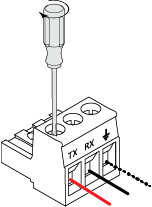Serial Port (I/O-8 Flex, DCIO/DCIO-H)
The RS-232 Serial Port component allows you to make a connection to the RS-232 connector on a I/O-8 Flex for Lua Scripting. When a connection is made, and an appropriate Lua script written, you can control and read from devices such as DVD players, recording hardware, video, lighting, and so on. Connections are made through a three-position Euro-style connector.
Inputs
RS-232 Serial Port - Serial port data to and from the RS-232 connector on the I/O-8 Flex, DCIO, or DCIO-H.
Outputs
Serial Port - Connects to the Control Script, Command Buttons, and Text Controller components. These components must be configured for Serial Port input.
Controls
|
Control |
Function |
Default / Range |
|---|---|---|
|
TX Bytes |
Displays a running total of the number of bytes sent. |
N / A |
|
RX Bytes |
Displays a running total of the number of bytes received. |
N / A |
|
Reset |
Resets both TX Bytes and RX Bytes to zero. |
N / A |
Properties
The Serial Port has no unique Properties. The Properties shown when the Serial Port is selected are for the I/O-8 Flex, or the DCIO / DCIO-H component.
Control Pins
The available Control Pins depend on settings in Properties.
|
Pin Name |
Value |
String |
Position |
Pins Available |
|---|---|---|---|---|
|
Reset |
Trigger |
Input/Output |
||
|
Receive Bytes |
Text Box |
Output |
||
|
Transmit Bytes |
Text Box |
Output |
||
RS-232 Details

|
Pinout
You must check the pinout of any equipment, including the cable, to be connected to a Q-SYS serial port for input or output. Many times in serial troubleshooting, problems may be solved by inserting a "null-modem" adapter or cable to swap the TX and RX pin positions. The TX pin on one end MUST be connected to an RX pin on the other and vise-verse for data to flow properly. |
